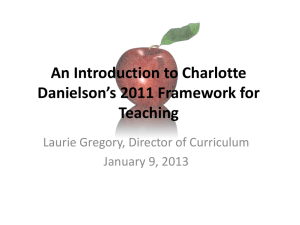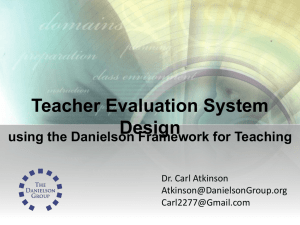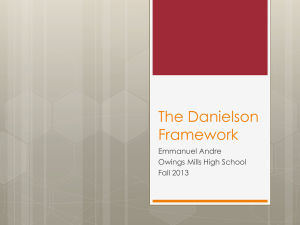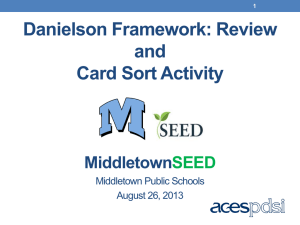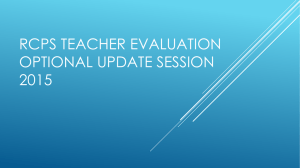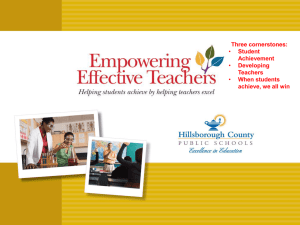Evaluating the school librarian using the
advertisement
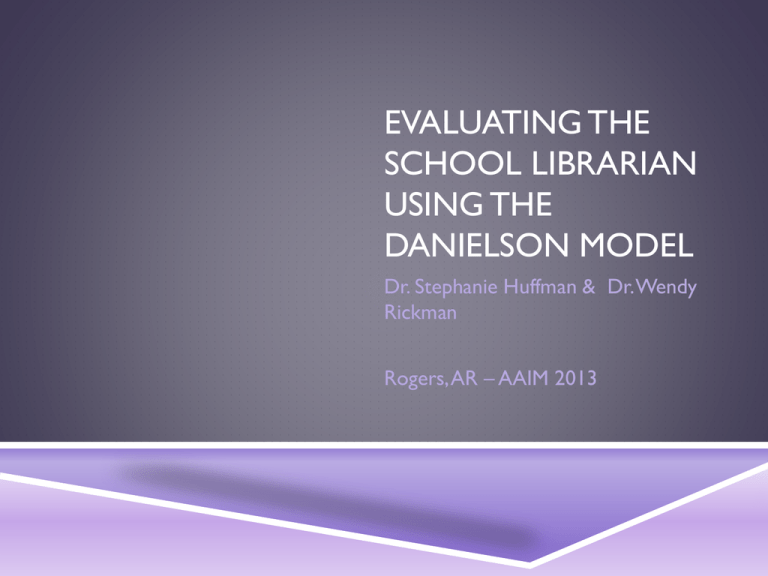
EVALUATING THE SCHOOL LIBRARIAN USING THE DANIELSON MODEL Dr. Stephanie Huffman & Dr. Wendy Rickman Rogers, AR – AAIM 2013 WHAT IS THE DANIELSON MODEL? ENHANCING PROFESSIONAL PRACTICE: A FRAMEWORK FOR TEACHING, 2ND ED. “A research-based set of components of instruction grounded in a constructivist view of learning and teaching …with its full value realized as the foundation for professional conversations among practitioners as they seek to enhance their skill in the complex task of teaching. (Danielson, 2007).” In this edition, she has addressed other areas of the curriculum for evaluation including school librarians, school counselors, instructional coaches, and others. DANIELSON MODEL FOR TEACHERS 2013, Charlotte Danielson’s Framework for Teaching, http://www.arkansased.org/divisions/human-resources-educator-effectiveness-and-licensure/office-of-educator-effectiveness/teacherevaluation-system/tess-teacher-support-training-documents DANIELSON MODEL FOR SCHOOL LIBRARIANS Domain 1: Planning & Preparation Domain 2: The Environment Domain 3: Delivery of Service •Demonstrating knowledge of literature and current trends in library/media practice and information technology. •Demonstrating knowledge of the school’s program and student information needs within that program. •Establishing goals for the library/media program appropriate to the setting and the students served. •Demonstrating knowledge of resources, both within and beyond the school and district, and access to such resources as interlibrary loan. •Planning the library/media program integrated with the overall school program. •Developing a plan to evaluate the library/media program. •Creating an environment of respect and rapport. •Establishing a culture for investigation and love of literature. •Establishing and maintaining library procedures. •Managing student behavior. •Organizing physical space to enable smooth flow. •Maintaining and extending the library collection in accordance with the school’s needs and within budget limitations. •Collaborating with teachers in the design of instructional units and lessons. •Engaging students in enjoying literature and in learning information skills. •Assisting students and teachers in the use of technology in the library/media center. Domain 4: Professional Responsibilities •Reflecting on practice. •Preparing and submitting reports and budgets. •Communicating with the larger community. •Participating in a professional community. •Engaging in professional development. •Showing professionalism. American Association for School Librarians. (2009). AASL’s L4L Sample School Librarian Performance and Evaluation System The Learning4Life school librarian evaluation system parallels Charlotte Danielson's domains for teacher evaluation but replaces her second domain with the Library Environment. All elements represent principles of best practice in teaching and school librarianship.The Learning 4 Life performance and evaluation system is designed for both self-assessment and job performance evaluation. http://aasl.ala.org/essentiallinks/index.php?title=Performance_Evaluatio n_of_School_Librarians AASL LEARNING 4 LIFE SCHOOL LIBRARIAN EVALUATION Domain 1: Planning & Preparation • Information literacy skills • The research process • Media and digital literacy and technology skills Domain 2: The Library Environment • Traffic flow • Self-directed use • Flexible learning space Domain 3: Instruction • • • • • The research process Information literacy Media literacy Digital literacy Technology skills Domain 4: Professional Responsibilities • Developing and administering the budget • Keeping accurate records regarding collection, circulation, and use • Analyzing data for planning and decision making • Supervising staff • Developing and maintaining a collection of resources. • Enhancement of professional knowledge ARKANSAS SCHOOL DISTRICT EVALS Conway School District Danielson’s Model for School Librarians Checksheet format Annual Statement of Goals/Personal Plan Formal & Informal Observation Form http://sau9.org/SAU9/Forms/Eval/CA LMSE_Prof_Eval_System2011.pdf Pocahontas School District Danielson’s Model for School Librarians http://www.nesc.k12.ar.us/view/98 COMMENTS OF INDIVIDUALS “I had my evaluation completed by my principal and I was needing a few things: Conduct a student/parent/teacher survey Develop a 3-year media specialist plan that will be a living document and will be updated each school year Find an evaluation for the library program (Hawkins, K. (2013). AAIM Listserv)” What is my three-year plan? What evidences or artifacts do I provide? 2013, Charlotte Danielson’s Framework for Teaching, http://www.arkansased.org/divisions/human-resources-educator-effectiveness-and-licensure/office-of-educator-effectiveness/teacherevaluation-system/tess-teacher-support-training-documents DANIELSON MODEL FOR SCHOOL LIBRARIANS Domain 1: Planning & Preparation • Demonstrating knowledge of literature and current trends in library/media practice and information technology. • Demonstrating knowledge of the school’s program and student information needs within that program. • Establishing goals for the library/media program appropriate to the setting and the students served. • Demonstrating knowledge of resources, both within and beyond the school and district, and access to such resources as interlibrary loan. • Planning the library/media program integrated with the overall school program. • Developing a plan to evaluate the library/media program. Evidence DANIELSON MODEL FOR SCHOOL LIBRARIANS Evidence Domain 2: The Environment • Creating an environment of respect and rapport. • Establishing a culture for investigation and love of literature. • Establishing and maintaining library procedures. • Managing student behavior. • Organizing physical space to enable smooth flow. DANIELSON MODEL FOR SCHOOL LIBRARIANS Domain 3: Delivery of Service • Maintaining and extending the library collection in accordance with the school’s needs and within budget limitations. • Collaborating with teachers in the design of instructional units and lessons. • Engaging students in enjoying literature and in learning information skills. • Assisting students and teachers in the use of technology in the library/media center. Evidence DANIELSON MODEL FOR SCHOOL LIBRARIANS Evidence Domain 4: Professional Responsibilities • Reflecting on practice. • Preparing and submitting reports and budgets. • Communicating with the larger community. • Participating in a professional community. • Engaging in professional development. • Showing professionalism. REFERENCES AASL. (2009). AASL’s L4L samples school librarian performance and evaluation system. Retrieved from: http://aasl.ala.org/essentiallinks/index.php?title=Performance_Evaluation_of_School_Libr arians. ADE. (2013). Smart card for teachers. TESS Teacher Support Training Documents. Retrieved from: http://www.arkansased.org/divisions/human-resourceseducator-effectiveness-and-licensure/office-of-educator-effectiveness/teacher-evaluationsystem/tess-teacher-support-training-documents. ASCD. (2013). Teacher evaluation: How does your state compare. Capitol Connection April 1, 2013. Retrieved from: http://t.congressweb.com/w/?NEJGDYDOYD. Conway School District Professional Evaluation System. (2011). Conway annual library media specialists evaluation. Retrieved from: http://sau9.org/SAU9/Forms/Eval/CALMSE_Prof_Eval_System2011.pdf. Danielson, C. (2007). Enhancing professional practice: A framework for teaching, 2nd ed. Pocahontas Public School District. (n.d.). J.2. – Library media specialist performance evaluation rubric. Retrieved from: http://www.nesc.k12.ar.us/view/98.
